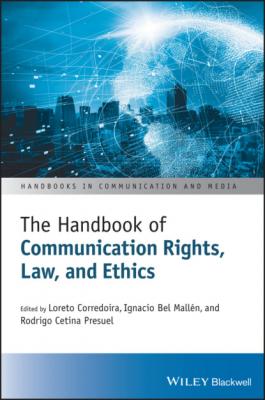The Handbook of Communication Rights, Law, and Ethics. Группа авторов
Чтение книги онлайн.
Читать онлайн книгу The Handbook of Communication Rights, Law, and Ethics - Группа авторов страница 7
 270
270
283 271
284 272
285 273
286 274
287 275
288 276
289 277
290 278
291 279
292 280
293 281
294 282
295 283
296 284
297 285
298 286
299 287
300 288
301 289
302 290
303 291
304 292
305 293
306 294
307 295
308 296
309 297
310 298
311 299
312 300
313 301
314 302
315 303
316 304
317 305
318 306
319 307
320 308
321 309
322 310
323 311
324 312
325 313
326 314
327 315
328 316
329 317
330 318
331 319
332 320
333 321
334 322
335 323
Preface
Monroe E. Price
I happily accepted the invitation of the editors – Profs. Loreto Corredoira, Ignacio Bel, and Rodrigo Cetina – to introduce this important work. The very occasion of our meeting resonates with the ambition of this book. I met the editors in 2019 at the annual conference of the International Association for Media and Communication Research (IAMCR), an organization long committed to exploring ways to enrich the flow of ideas of communication and society across cultures, across systems, across theoretical approaches. This book is emblematic of what might be called the exploratory spirit of the IAMCR. The collection is designed to underscore communication rights as that idea has flourished within the traditions of the editors and in conversation with competing and complementary ideas developed in other traditions.
The book is timely for many reasons. There is an imperative resulting from the massive transformations in media technology and in the tsunami of change that goes under the name of social media. The world is, and has been for recent decades, a jurisdictional and cultural experimental zone for testing or imposing policy, with the force of circumstances driving governments, civil society, political parties, nongovernmental organizations, and others in conflicting directions, confronting issues of power, impact, and conformity to norms.
Dramatic shifts – in geopolitics, in technology, and in institutions, create a demand for rethinking the relationship between media technologies and freedom. Recourse to first principles and review of historic traditions can, in such a context, lead to new insights. That is the significant effort of this book.
In my own work,1 I have tried to think about alternate ways of characterizing large-scale efforts to shape systems of information flow. “Communication rights” in this approach are nestled in and products of other expansive themes or tendencies. These overall themes are sometimes posed as foundational rights (prescribed, one could find, in the International Covenant of Civil and Political Rights) or constructed through observation of what societies actually do. Examples, from my work, include these actions of major forces in the information space: the shaping of strategic infrastructures for channeling, encouraging, or restricting media flows or the invention and uses of forceful narratives (call them strategic narratives) to affect public behaviors and institutional choices. All this occurs under an umbrella of complex operations that I have described under the term “Markets for Loyalties.” How these ideas relate to communications rights or how communications rights flourish under technological and political pressures – this becomes the ongoing challenge.
Strategic Infrastructures
Everywhere about us, we see the material remnants of historic approaches to governing speech and society, and this volume – in its array of authorial backgrounds – manifests a variety of experiences with regulating freedom of expression and communication from different countries around the world. These distributed studies yield a catalogue of techniques used to mobilize, affect, or otherwise regulate and control societies. Technologies change: fax machines in dissident Eastern Europe, audiotapes in revolutionary Iran, flash drives in Cuba, smartphones in Egypt, sophisticated apps in Hong Kong. We aspire to explain how these technical interventions become effective tools for furthering freedoms but sometime become hijacked, melded with surveillance in ways subversive of an original goal. We recognize that it is not the technology alone, but the